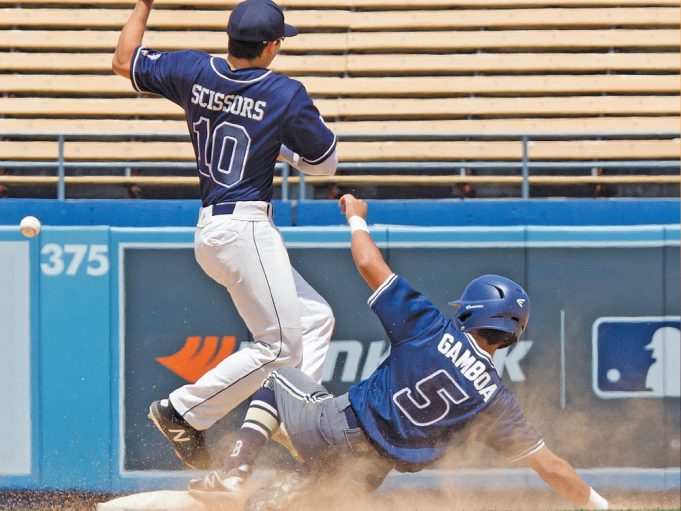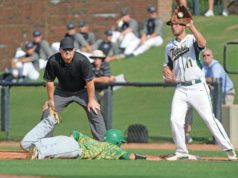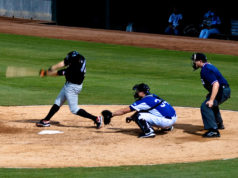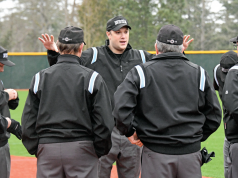Some umpires are unabashed about their love of double plays; they do serve to shorten the inning. Double plays can occur in a variety of ways but most occur on ground balls with a force play included. Line-drive twin killings are very quick and usually leave very little room for argument. When two outs are called because of interference, the challenge can be determining which player is the second out. Of course if there was already one out, the discussion is purely academic. With no one out though, the umpires must get it right.
A double play is a play by the defense that results in two offensive players being put out as a result of continuous action, providing there is no error between putouts (NFHS 2-29-2; NCAA 2-24; pro Double Play Definition). Except where noted, the material applies equally to NFHS, NCAA and pro rules.
Force play interference. The call here is straightforward. In NFHS and NCAA, whenever the force play slide rule is violated, the second out is always on the batter-runner (NFHS 8-4-2b Pen.; NCAA 8-4c Pen.).
Play 1: With a runner on first, B1 grounds to F6, who flips to F4 at second. R1 slides behind the bag, where F4 is standing and (a) contacts, or (b) does not contact F4. Ruling 1: This is interference and a double play in both (a) and (b)because the slide was not direct to the base or away from the fielder. It does not matter whether the non-direct slide resulted in contact or altered the play. If the slide is toward the fielder, contact is not a factor.
In the preceding play, no interference would be called under pro rules because the runner is not required to slide in a direct line between the bases. However, he can interfere by not engaging in a “bona fide slide,” and initiating (or attempting to make) contact with the fielder for the purpose of breaking up a double play. A bona fide slide occurs when the runner: (1) begins his slide (i.e., makes contact with the ground) before reaching the base; (2) is able to and attempts to reach the base with his hand or foot; (3) is able to and attempts to remain on the base (except home plate) after completion of the slide; and (4) slides within reach of the base without changing his pathway for the purpose of initiating contact with a fielder. If he does interfere, the result would be the same as in the amateur codes — both the runner and the batter-runner are out (6.01a6).
Interference by batter-runner.
The first out is clearly the batter-runner. After that, the codes differ on which other runner is declared out. In NFHS, the second out is the other runner who would have been involved in the double play. If the umpire is uncertain as to who would have been played on, the runner closest to home is called out (NFHS 8-4-2g). In NCAA and pro, the second out is always the runner closest to home (NCAA 8-5e; pro 6.01a7). Any other runners return to the base legally reached at the time of interference.
Play 2: Runners are on the corners when B1 attempts to bunt. R1 is off with the pitch, but R3 is holding. B1’s bunt is a pop-up near home plate. As F2 prepares to catch the ball, B1 bumps him. The umpire is certain F2 would have caught the ball and then thrown to first to double up R1. Ruling 2: In NFHS, B1 and R1 are out as R1 would have been doubled up. R3 stays at third. In NCAA and pro, B1 is out, R3 (nearest home) is also out and R1 returns to first.
Interference by other runners.
Regardless of whether or not the interfering player was already out when the interference occurred, that is the first out, but again the second out in NFHS differs from NCAA and pro. In NFHS, the other runner who would have been involved in the double play is called out (same as if the batter-runner had interfered) and at the higher levels, the batter-runner is the second out (NFHS 8-4-1h, 8-4-2g, 8.4.2 Cmt; NCAA 8-5d; pro 6.01a6). Any other runners return to the base legally reached at the time of interference.
Play 3: With runners on first and second and no outs, B1 hits a ground ball to the shortstop. R2 stops to avoid colliding with the fielder, then as F6 prepares to throw to second, R2 bumps into him. F6 and the loose ball fall to the ground, preventing the likely double play. Ruling 3: The ball is dead. R2 is out for interfering with the shortstop’s attempt to complete a play. In NFHS, R1 is also out because he was “the other runner involved.” B1 remains at first. In NCAA and pro, B1 is out for the preceding runner’s interference. R1 is returned to first.
Returning runners.
As mentioned, any other runners return to the base legally reached at the time of interference. Here’s a play in which it is clear which runners are out, but the issue is to which base is the remaining runner entitled.Play 4: With runners on second and third, the ball is hit to F3, who steps on first and throws home. While R3 is in a rundown between home and third, R2 makes it to third. To escape the rundown, R3 reaches up and touches the thrown ball and goes on to touch the plate. Ruling 4: R3 is out for interfering with a thrown ball and R2 must return to second; he did not legally acquire third because R3 was entitled to it (NFHS 8-2-9; NCAA 2-51 Nt 6; pro 6.01a Pen. Cmts 3 & 4).
When to call it?
When it is not obvious a double play is in the making as it is on a force play slide at second, there are somewhat subtle differences in the codes on whether or not to call a double play. In NFHS, the umpire must believe the defense could have completed a double play (8-4-1h, 8.4.1D, 9.3.2C). It does not matter if the interference was intentional or accidental. In NCAA, the rule is the same except the interference must be deliberate for two outs to be called (8-5d). In pro, two are out if a double play is possible, whether or not a double play could have been completed, but only if the interference is obvious, deliberate and willful (designed to break up the double play) (6.01a6/7).
Play 5: While advancing to second, R1 is hit by a batted ball that prevents an obvious double play on him and the batter-runner. Ruling 5: In NFHS, both the runner and the batter-runner are declared out. In NCAA and pro, only R1 is out unless the umpire rules the interference was intentional.
Play 6: With R2 on second and R3 on third, B3 hits a sharp ground ball toward F6, who is pushed by R2. Ruling 6: Interference causes the ball to become dead and R2 is out. In NFHS, if the umpire judges F6 could have tagged R2 with the ball and then thrown out R3 at home, R3 is also called out. If it is apparent F6 was about to tag R2 and would also retire B3 at first for a double play, the umpire would declare both R2 and B3 out. If the umpire rules F6 could not have retired any runner even if he fielded the ball cleanly, only R2 is out. In NCAA play, because a push is clearly intentional, the umpire need only determine if the defense could have completed a double play. If so, the batter-runner is also called out. Under pro rules, because it is not obvious R2 was attempting to intentionally break up a double play, only R2 should be called out. If the umpire judged R2 interfered with the obvious intent to break up a double play, B1 would also be out.
What's Your Call? Leave a Comment:
Note: This article is archival in nature. Rules, interpretations, mechanics, philosophies and other information may or may not be correct for the current year.
This article is the copyright of ©Referee Enterprises, Inc., and may not be republished in whole or in part online, in print or in any capacity without expressed written permission from Referee. The article is made available for educational use by individuals.


















